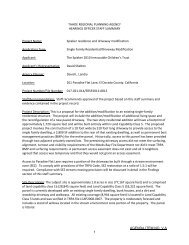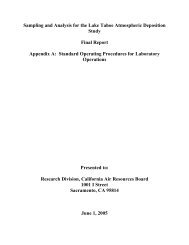FEIS - Tahoe Regional Planning Agency
FEIS - Tahoe Regional Planning Agency
FEIS - Tahoe Regional Planning Agency
Create successful ePaper yourself
Turn your PDF publications into a flip-book with our unique Google optimized e-Paper software.
RESPONSE TO COMMENTS ON THE DEIS<br />
B o u l d e r B a y C o m m u n i t y E n h a n c e m e n t P r o g r a m P r o j e c t E I S<br />
These parking spaces are not included in the parking space counts listed above for the<br />
Alternatives, but will continue to be open for public use.<br />
Comment 63-b: Comment Summary - Redo of traffic study - decline in traffic hard to believe.<br />
Alternative C results in fewer trips than Alternative A existing conditions and the<br />
baseline existing conditions shown on Table 8.5-2. Master Response 2 provides an<br />
alternative baseline analysis, that utilizes existing conditions, adjusted to 2006<br />
economic conditions as the baseline. This analysis indicates Alternative C decreases<br />
traffic.<br />
Comment Letter 79 – Gergans, Nicole, League to Save Lake <strong>Tahoe</strong>, 12/9/2009<br />
Comment 79-a: Comment Summary – Does not believe VMT will decrease with Project.<br />
Alternative C results in fewer trips than Alternative A existing conditions and the<br />
baseline existing conditions shown on Table 8.5-2. Master Response 2 provides<br />
information related to an Alternative existing baseline analysis. A reduction in<br />
vehicle trips corresponds to a reduction in VMT.<br />
Comment 79-b: Comment Summary – Existing VMTs based on potential full capacity uses, instead of<br />
actual existing VMTs, leads erroneous conclusions about Project VMTs.<br />
Please see response to comment 79-a.<br />
Comment 79-c: Comment Summary - Trip generation rate assumptions may be flawed because they<br />
were not based on data from the Biltmore or other casinos in Nevada, but instead on<br />
rates from casinos in Illinois, Iowa, and California.<br />
The information available for casino trip generation is limited and varied among<br />
sources. Several sources of casino trip generation were evaluated, including<br />
information on Nevada casinos, to determine the most appropriate and similar casino<br />
uses to the Proposed Project and Alternatives. The following sources contain Nevada<br />
casino trip generation information:<br />
• Trip Generation Rates for Las Vegas Area Hotel-Casinos, Ackeret, Hosea, ITE<br />
Journal, May 1992.<br />
• Recalibration of Trip Generation Model for Las Vegas Casinos, Rowe, Kaseko,<br />
Ackeret, ITE Journal, May 2002.<br />
• Hotel/Casino Trip Generation Study, Reno, Nevada, Barton-Aschman<br />
Associates, Inc., 1985.<br />
The casinos surveyed for these studies have different characteristics than the<br />
Proposed Project and Alternatives. The surveyed casinos in the Nevada studies<br />
above are larger in size, with an average of over 2,000 gaming positions, and an<br />
average number of employees over 1,600. In addition, these casinos are located in<br />
downtown settings and have trip characteristics that are different than the Proposed<br />
Project and Alternatives. It is likely that the overall trip generation estimate would<br />
have been lower if the Las Vegas Casino trip generation rate was applied to the<br />
Boulder Bay. The trip generation rates developed for the Las Vegas casinos studied<br />
are lower than a facility such as Boulder Bay because most Las Vegas casino guests<br />
park once at the casino and use other transportation to get around (e.g., take transit or<br />
walk to other casinos) and the Las Vegas casinos are larger with more amenities and<br />
can better keep guests on-site (e.g., there is also less draw to other recreation<br />
opportunities).<br />
PAGE 8- 26 HAUGE BRUECK ASSOCIATES SEPTEMBER 8 , 2010






